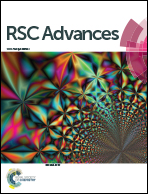Physical vapor deposited organic ferroelectric diisopropylammonium bromide film and its self-powered photodetector characteristics
Abstract
Organic diisopropylammonium bromide (DIPAB) is a promising material with superior ferroelectric characteristics. However, the DIPAB continuous film, which is essential to explore its application potential, is challenging because its crystallization kinetics favors island-like microcrystalline growth. In this work, the continuous and uniform deposition of organic ferroelectric DIPAB film on a single crystalline Si(100) substrate is demonstrated by a thermal evaporation process. Structural and optical studies reveal that the film is c-axis oriented with an optical bandgap of 3.52 eV. The topographic image displays well-connected grain-like surface morphology with ∼2 nm roughness. The ferroelectric domain studies illustrate the in-plane orientation of the domains, which is in accordance with c-axis oriented film where polarization is along the in-plane b-axis. The phase and amplitude responses of the domains display hysteresis and butterfly characteristics, respectively and thereby endorse the ferroelectric nature of the film. Importantly, it is demonstrated that the DIPAB film exhibits remarkable self-powered UV-Vis photodetector characteristics with responsivity of 0.66 mA W−1 and detectivity of 2.20 × 109 Jones at 11.45 mW cm−2 light intensity. The fabricated DIPAB film reported in this work can widen its application potential in self-powered photodetector and other optoelectronic devices.



 Please wait while we load your content...
Please wait while we load your content...